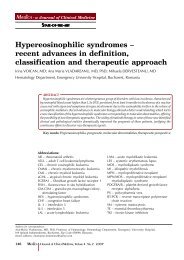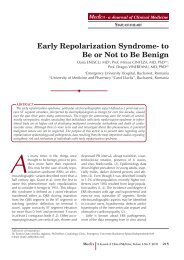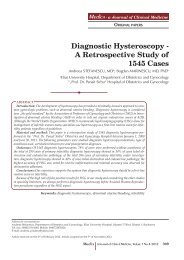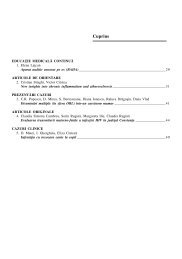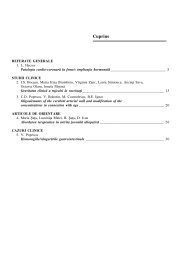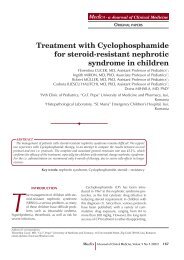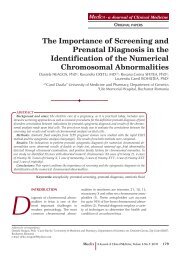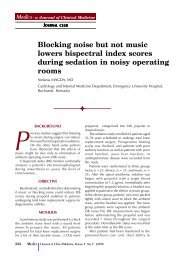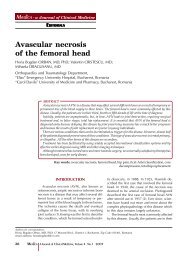Activated protein C resistance and pregnancy - MÃDICA - a Journal ...
Activated protein C resistance and pregnancy - MÃDICA - a Journal ...
Activated protein C resistance and pregnancy - MÃDICA - a Journal ...
Create successful ePaper yourself
Turn your PDF publications into a flip-book with our unique Google optimized e-Paper software.
M K pag 101<br />
M K pag 101<br />
ACTIVATED PROTEIN C RESISTANCE AND PREGNANCY – DEPARTMENT’S OF HAEMATOLOGY, COLTEA CLINICAL HOSPITAL EXPERIENCE<br />
this conduce towards an activated Factor V<br />
molecule resistant to cleavage by APC. The<br />
procoagulant activity of activated Factor V is normal.<br />
Further, another genetic mutations of FV<br />
which lead to APCR <strong>and</strong> contribute to an increased<br />
risk of thrombosis (R2 allele, FV Cambridge<br />
R306T mutation or factor V Hong Kong<br />
R306G mutation) (2,3) have been identified.<br />
In spite of all, the factor V Leiden variant incidence<br />
is the highest (about 5% – 12% in general<br />
population) <strong>and</strong> it is considered responsible<br />
for up 95% of cases of APC <strong>resistance</strong>.<br />
The risk of thrombosis is a 7.9 fold increased<br />
for heterozygous <strong>and</strong> a 91 fold increased for<br />
homozygous with Factor V Leiden mutation that<br />
is considered the most frequently thrombophilia<br />
being found in 20 to 60% of patients with recurrent<br />
thrombosis.<br />
Acquired <strong>resistance</strong> to activated <strong>protein</strong> C<br />
There are many conditions that lead up to<br />
APC resistant without any mutations: oral<br />
contraceptive use, <strong>pregnancy</strong>, inflammatory diseases,<br />
acute thrombotic events <strong>and</strong> cancers (4).<br />
Lupus anticoagulants are also associated with a<br />
reduced sensitivity to APC (5). Demographic<br />
factors, female gender, elderly, obesity, high<br />
cholesterol, high triglycerides <strong>and</strong> hypertension<br />
have a positive correlation with APC <strong>resistance</strong><br />
(4). Mechanisms of acquired APC <strong>resistance</strong><br />
described are: increased plasma levels of factor<br />
VIII in acute-phase reactions, in patients with<br />
acute thrombotic events or in cancer patients<br />
(6), high factor VII levels in oral contraceptive<br />
users or lupus anticoagulants inhibition on the<br />
action of APC on factor V (7). The <strong>pregnancy</strong> is<br />
associated with increased <strong>resistance</strong> to activated<br />
<strong>protein</strong> C dependent on elevated coagulations<br />
factor VIII <strong>and</strong> V levels but this is not real risk<br />
factor for venous thrombosis (8).<br />
Haemostatic changes in <strong>pregnancy</strong><br />
Normal <strong>pregnancy</strong> <strong>and</strong> puerperium are<br />
characterized by a marked increased in<br />
the procoagulant activity in maternal blood (9).<br />
Virchow’s triad in normal <strong>pregnancy</strong> is characterized<br />
by venous stasis, venous hypotonia or<br />
vascular damage <strong>and</strong> hypercoagulability. The<br />
most blood coagulation factors <strong>and</strong> fibrinogen<br />
increase during <strong>pregnancy</strong>: FVII <strong>and</strong> FX are mild<br />
increasing, Fibrinogen <strong>and</strong> FVIII are 2 fold increasing,<br />
von Willebr<strong>and</strong> Factor increases 3-fold<br />
<strong>and</strong> remains elevated some period post partum<br />
<strong>and</strong> FV gradual rises (10). FXII, X <strong>and</strong> IX increase<br />
progressively in contrast with FXI that is<br />
the only blood coagulation factor that decrease.<br />
Tissue factor (TF) no change <strong>and</strong> it has a VTE<br />
protecting role in <strong>pregnancy</strong>. Another hypercoagulability<br />
causes in <strong>pregnancy</strong> are the natural<br />
coagulation inhibitors changes: total <strong>and</strong> free<br />
<strong>protein</strong> S decrease about 30% <strong>and</strong> may remain<br />
decreased for at least up to 2 months postpartum,<br />
<strong>protein</strong> C remain constant or increase<br />
but Heparin cofactor II <strong>and</strong> Thrombomodulin<br />
increase in <strong>pregnancy</strong>. Level of ATIII remains<br />
stable during <strong>pregnancy</strong>. Fibrinolytic capacity is<br />
diminished during <strong>pregnancy</strong>, mainly because<br />
of markedly increased levels of plasminogen<br />
activator inhibitor-1 (PAI-1) from endothelial<br />
cells <strong>and</strong> plasminogen activator inhibitor-2 (PAI-<br />
2) from the placenta (11). The changes in the<br />
haemostatic system progress with <strong>pregnancy</strong><br />
evolution <strong>and</strong> are maximal around term; its<br />
help in maintaining placental function during<br />
<strong>pregnancy</strong>, minimizing intrapartum blood loss<br />
<strong>and</strong> preparing the haemostatic challenge of<br />
delivery. Haemostatic system returns to nonpregnant<br />
state in 4 – 6 weeks post-delivery. The<br />
incidence of VTE in <strong>pregnancy</strong> is 1/1000 deliveries<br />
(6 fold higher than in general female population<br />
of child-bearing age). An important anticoagulant<br />
mechanism changed is acquired APC<br />
<strong>resistance</strong> that was reported in up to 50% of<br />
normal pregnancies. The cause of this change<br />
is the increase level of FVIII <strong>and</strong> FV, decrease<br />
level of PS or APC inhibitors (12).<br />
Complications induced by APCR in<br />
<strong>pregnancy</strong><br />
Normal <strong>pregnancy</strong> is characterized by acquired<br />
activated Protein C <strong>resistance</strong>, but<br />
this hypercoagulable state doesn’t induce<br />
thrombotic complications <strong>and</strong> doesn’t need<br />
antithrombotic prophylaxis. Instead, the inherited<br />
activated Protein C <strong>resistance</strong> induced by<br />
FV Leiden has often complicated <strong>pregnancy</strong>.<br />
The mutation induce a three to four fold higher<br />
risk of an adverse <strong>pregnancy</strong> outcome (13) <strong>and</strong><br />
has a stronger association with severe <strong>and</strong> earlyonset<br />
preeclampsia (14, 15). Also, recurrent miscarriages,<br />
defined as three early consecutive<br />
losses or two late <strong>pregnancy</strong> losses after 12-<br />
weeks gestational age (16) has been shown to<br />
be associated with APCR. The data on the risk<br />
of intrauterine fetal growth restriction (IUGR)<br />
are more limited <strong>and</strong> conflicting (17, 18).<br />
Mædica A <strong>Journal</strong> of Clinical Medicine, Volume 4 No.2 2009 101




